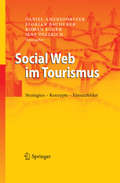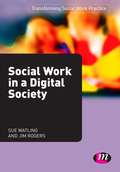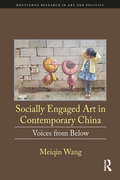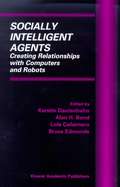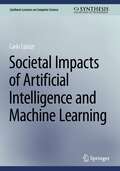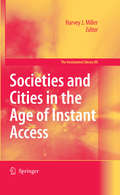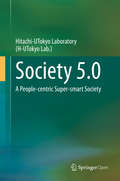- Table View
- List View
Social Video Content Delivery (SpringerBriefs in Electrical and Computer Engineering)
by Zhi Wang Jiangchuan Liu Wenwu ZhuThis brief presents new architecture and strategies for distribution of social video content. A primary framework for socially-aware video delivery and a thorough overview of the possible approaches is provided. The book identifies the unique characteristics of socially-aware video access and social content propagation, revealing the design and integration of individual modules that are aimed at enhancing user experience in the social network context. The change in video content generation, propagation, and consumption for online social networks, has significantly challenged the traditional video delivery paradigm. Given the massive amount of user-generated content shared in online social networks, users are now engaged as active participants in the social ecosystem rather than as passive receivers of media content. This revolution is being driven further by the deep penetration of 3G/4G wireless networks and smart mobile devices that are seamlessly integrated with online social networking and media-sharing services. Despite increasingly abundant bandwidth and computational resources, the ever-increasing volume of data created by user-generated video content--along with the boundless coverage of socialized sharing--presents unprecedented challenges.
Social Vulnerability to COVID-19: Impacts of Technology Adoption and Information Behavior (Synthesis Lectures on Information Concepts, Retrieval, and Services)
by Dan Wu Xiaojun Yuan DeeDee Bennett GayleThis book provides an overview of the impact of the pandemic in China and the USA and presents a research agenda for use, access, and adoption of information and communication technologies (ICT) in the era of COVID-19. The global COVID-19 pandemic changed lives overnight and exposed socially vulnerable populations to ever-challenging situations. One significant challenge was the use, access, and adoption of technological resources. To understand how socially vulnerable populations managed the COVID-19 pandemic and adapt to the new normal, it is important for researchers and practitioners to identify the challenges and understand the perceptions of technologies. Through various research studies, this edited volume addresses the impact of the global COVID-19 pandemic and the adoption of technologies (from artificial intelligence to telehealth and telecommunications) among some socially vulnerable populations (including children, older adults, COVID-19 patients, and general marginalized populations) in the world. The information divide faced by socially vulnerable groups is studied as well as the dimension of vulnerabilities and the impacts of specific technologies.
Social Web Artifacts for Boosting Recommenders: Theory and Implementation (Studies in Computational Intelligence #487)
by Cai-Nicolas ZieglerRecommender systems, software programs that learn from human behavior and make predictions of what products we are expected to appreciate and purchase, have become an integral part of our everyday life. They proliferate across electronic commerce around the globe and exist for virtually all sorts of consumable goods, such as books, movies, music, or clothes.At the same time, a new evolution on the Web has started to take shape, commonly known as the “Web 2.0” or the “Social Web”: Consumer-generated media has become rife, social networks have emerged and are pulling significant shares of Web traffic. In line with these developments, novel information and knowledge artifacts have become readily available on the Web, created by the collective effort of millions of people.This textbook presents approaches to exploit the new Social Web fountain of knowledge, zeroing in first and foremost on two of those information artifacts, namely classification taxonomies and trust networks. These two are used to improve the performance of product-focused recommender systems: While classification taxonomies are appropriate means to fight the sparsity problem prevalent in many productive recommender systems, interpersonal trust ties – when used as proxies for interest similarity – are able to mitigate the recommenders' scalability problem.
Social Web im Tourismus: Strategien - Konzepte - Einsatzfelder
by Daniel Amersdorffer Florian Bauhuber Roman Egger Jens OellrichZiel der Autoren ist es, Mechanismen und Prinzipien des Social Webs im Tourismus aufzuzeigen. Neben den theoretischen Grundlagen erläutern sie die praktischen Anwendungen und illustrieren das Thema anhand vieler Best-Practice-Beispiele. Leser erfahren, welche Bedeutung das Social Web und seine grundlegenden Mechanismen haben, so dass Internet-Aktivitäten besser geplant und an neue Entwicklungen angepasst werden können. Für Akteure in der Tourismusbranche, aber auch Wissenschaftler, die einen Einstieg in die touristische Praxis des Social Web suchen.
Social Work in a Digital Society
by Sue Watling Jim RogersThis book will help students develop their understanding of how the internet is impacting on social work education and practice in 21st century. Essential reading for students interested in the influence of digital technology and social media, including the impact of digital divides, this book looks at how the value-base of social work can have a positive effect on service users and carers who engage with digital services.
Socialbots and Their Friends: Digital Media and the Automation of Sociality
by Robert W. Gehl Maria BakardjievaMany users of the Internet are aware of bots: automated programs that work behind the scenes to come up with search suggestions, check the weather, filter emails, or clean up Wikipedia entries. More recently, a new software robot has been making its presence felt in social media sites such as Facebook and Twitter – the socialbot. However, unlike other bots, socialbots are built to appear human. While a weatherbot will tell you if it's sunny and a spambot will incessantly peddle Viagra, socialbots will ask you questions, have conversations, like your posts, retweet you, and become your friend. All the while, if they're well-programmed, you won't know that you're tweeting and friending with a robot. Who benefits from the use of software robots? Who loses? Does a bot deserve rights? Who pulls the strings of these bots? Who has the right to know what about them? What does it mean to be intelligent? What does it mean to be a friend? Socialbots and Their Friends: Digital Media and the Automation of Sociality is one of the first academic collections to critically consider the socialbot and tackle these pressing questions.
Socialbots and Their Friends: Digital Media and the Automation of Sociality
by Robert W. Gehl Maria BakardjievaMany users of the Internet are aware of bots: automated programs that work behind the scenes to come up with search suggestions, check the weather, filter emails, or clean up Wikipedia entries. More recently, a new software robot has been making its presence felt in social media sites such as Facebook and Twitter – the socialbot. However, unlike other bots, socialbots are built to appear human. While a weatherbot will tell you if it's sunny and a spambot will incessantly peddle Viagra, socialbots will ask you questions, have conversations, like your posts, retweet you, and become your friend. All the while, if they're well-programmed, you won't know that you're tweeting and friending with a robot. Who benefits from the use of software robots? Who loses? Does a bot deserve rights? Who pulls the strings of these bots? Who has the right to know what about them? What does it mean to be intelligent? What does it mean to be a friend? Socialbots and Their Friends: Digital Media and the Automation of Sociality is one of the first academic collections to critically consider the socialbot and tackle these pressing questions.
The “Socialist Transformation” of Memory: Reversing Chinese History through “Pernicious-Vestiges” Media Discourse (China Perspectives)
by Yusi Liu Ye MaThrough discourse analysis and historical comparison of "Pernicious Vestiges" (Yí Dú/遗毒) narrative in the news text of People’s Daily, this book is devoted to revealing its primary metaphors and political functions in China. "Pernicious Vestiges" (Yí Dú/遗毒) is one of the most frequently used words in contemporary Chinese historical narration, as well as a constantly changing rhetorical direction in new China's media discourse, whose function is to remold memory. Over the past 76 years, the "Pernicious Vestiges" narrative continuously constructed by People’s Daily, the official newspaper of the CPC Central Committee, reflects the views of China’s political elite and represents the ruling party's evaluation and re-evaluation of historical events. The findings of this book challenge the myth that memory is naturally superior to forgetting, reflect on the ethics of memory in "Pernicious Vestiges" narratives and the erasure of their own justice, and suggest that the critical space compressed by "Pernicious Vestiges" narratives should be returned to restore the order of memory and historical reflection. This book will be an excellent read for students and scholars of Chinese studies, media studies, and those who are interested in political communication and collective memory in general.
The “Socialist Transformation” of Memory: Reversing Chinese History through “Pernicious-Vestiges” Media Discourse (China Perspectives)
by Yusi Liu Ye MaThrough discourse analysis and historical comparison of "Pernicious Vestiges" (Yí Dú/遗毒) narrative in the news text of People’s Daily, this book is devoted to revealing its primary metaphors and political functions in China. "Pernicious Vestiges" (Yí Dú/遗毒) is one of the most frequently used words in contemporary Chinese historical narration, as well as a constantly changing rhetorical direction in new China's media discourse, whose function is to remold memory. Over the past 76 years, the "Pernicious Vestiges" narrative continuously constructed by People’s Daily, the official newspaper of the CPC Central Committee, reflects the views of China’s political elite and represents the ruling party's evaluation and re-evaluation of historical events. The findings of this book challenge the myth that memory is naturally superior to forgetting, reflect on the ethics of memory in "Pernicious Vestiges" narratives and the erasure of their own justice, and suggest that the critical space compressed by "Pernicious Vestiges" narratives should be returned to restore the order of memory and historical reflection. This book will be an excellent read for students and scholars of Chinese studies, media studies, and those who are interested in political communication and collective memory in general.
Socially Aware Organisations and Technologies. Impact and Challenges: 17th IFIP WG 8.1 International Conference on Informatics and Semiotics in Organisations, ICISO 2016, Campinas, Brazil, August 1-3, 2016, Proceedings (IFIP Advances in Information and Communication Technology #477)
by Maria Cecilia Calani Baranauskas Kecheng Liu Lily Sun Vânia Paula de Almeida Neris Rodrigo Bonacin Keiichi NakataThis book constitutes the refereed proceedings of the 17th IFIP WG 8.1 International Conference on Informatics and Semiotics in Organisations, ICISO 2016, held in Campinas, Brazil, in August 2016.The 16 full papers and 9 short papers presented were carefully reviewed and selected from 30 submissions. The papers are organized in the following topical sections: organisational semiotics: theory and research; semiotics of interactions and socially aware user interface design; digital business ecosystems; knowledge management and engineering; and trends, challenges and new issues in education, health and eScience systems.
Socially Engaged Art in Contemporary China: Voices from Below (Routledge Research in Art and Politics)
by Meiqin WangThis book provides an in-depth and thematic analysis of socially engaged art in Mainland China, exploring its critical responses to and creative interventions in China’s top-down, pro-urban, and profit-oriented socioeconomic transformations. It focuses on the socially conscious practices of eight art professionals who assume the role of artist, critic, curator, educator, cultural entrepreneur, and social activist, among others, as they strive to expose the injustice and inequality many Chinese people have suffered, raise public awareness of pressing social and environmental problems, and invent new ways and infrastructures to support various underprivileged social groups.
Socially Engaged Art in Contemporary China: Voices from Below (Routledge Research in Art and Politics)
by Meiqin WangThis book provides an in-depth and thematic analysis of socially engaged art in Mainland China, exploring its critical responses to and creative interventions in China’s top-down, pro-urban, and profit-oriented socioeconomic transformations. It focuses on the socially conscious practices of eight art professionals who assume the role of artist, critic, curator, educator, cultural entrepreneur, and social activist, among others, as they strive to expose the injustice and inequality many Chinese people have suffered, raise public awareness of pressing social and environmental problems, and invent new ways and infrastructures to support various underprivileged social groups.
Socially Enhanced Services Computing: Modern Models and Algorithms for Distributed Systems
by Schahram Dustdar, Daniel Schall, Florian Skopik, Lukasz Juszczyk and Harald PsaierSocially enhanced Services Computing deals with a novel and exciting new field at the intersection between Social Computing, Service-oriented Computing, Crowd Computing, and Cloud Computing. The present work presents a collection of selected papers by the editors of this volume, which they feel will help the reader in understanding this field. The approach discussed allows for a seamless integration of people into trusted dynamic compositions of Human-provided Services and Software-based services, thus empowering new interaction models and processes in massive collaboration scenarios in a Future Internet.
Socially Intelligent Agents: Creating Relationships with Computers and Robots (Multiagent Systems, Artificial Societies, and Simulated Organizations #3)
by Kerstin Dautenhahn Alan H. Bond Bruce Edmonds Lola CanameroSocially situated planning provides one mechanism for improving the social awareness ofagents. Obviously this work isin the preliminary stages and many of the limitation and the relationship to other work could not be addressed in such a short chapter. The chief limitation, of course, is the strong commitment to de?ning social reasoning solely atthe meta-level, which restricts the subtlety of social behavior. Nonetheless, our experience in some real-world military simulation applications suggest that the approach, even in its preliminary state, is adequate to model some social interactions, and certainly extends the sta- of-the art found in traditional training simulation systems. Acknowledgments This research was funded by the Army Research Institute under contract TAPC-ARI-BR References [1] J. Gratch. Emile: Marshalling passions in training and education. In Proceedings of the Fourth International Conference on Autonomous Agents, pages 325–332, New York, 2000. ACM Press. [2] J. Gratch and R. Hill. Continous planning and collaboration for command and control in joint synthetic battlespaces. In Proceedings of the 8th Conference on Computer Generated Forces and Behavioral Representation, Orlando, FL, 1999. [3] B. Grosz and S. Kraus. Collaborative plans for complex group action. Arti?cial Intelli gence, 86(2):269–357, 1996. [4] A. Ortony, G. L. Clore, and A. Collins. The Cognitive Structure of Emotions. Cambridge University Press, 1988. [5] R.W.PewandA.S.Mavor,editors. Modeling Human and Organizational Behavior. National Academy Press, Washington D.C., 1998.
Socially Responsible IT Management
by Michael ErbschloeSocially Responsible IT Management shows IT professionals how to overcome the social crisis that has resulted from the wide-spread use of information technology. By responsibly managing security threats, protecting individual privacy, reducing hazardous waste, and minimizing other negative effects on IT staff and computer users, as well as ordinary citizens around the world, IT professionals can benefit the society at large and reap rewards for their own organizations as well.Scandals at Enron, Andersen, Sotheby's and Christie's, Merrill Lynch, and Tyco are fueling a crisis of confidence in business. Regulators, voters, investors, customers, and employees are demanding that businesses be more socially responsible. Rhetoric is not enough, all organizations need to demonstrate that they are living up to social expectations. Erbschloe shows managers how to take charge of key aspects of their IT operations and follow a morally, ethically, and legally correct path to success.· Supported by author speaking tour and "Computer Economics" website, www.computereconomics.com · Step-by-step instructions on how to accomplish objectives of privacy and security· Explains principles of ergonomics, energy efficiency, and recycling that can bring return on investment
Societal Impacts of Artificial Intelligence and Machine Learning (Synthesis Lectures on Computer Science)
by Carlo LipizziThis book goes beyond the current hype of expectations generated by the news on artificial intelligence and machine learning by analyzing realistic expectations for society, its limitations, and possible future scenarios for the use of this technology in our current society. Artificial Intelligence is one of the top topics today and is inflating expectations beyond what the technology can do in the foreseeable future. The future cannot be predicted, but the future of some elements of our society, such as technology, can be estimated. This book merges the modeling of human reasoning with the power of AI technology allowing readers to make more informed decisions about their personal or financial decisions or just being more educated on current technologies. This book presents a model that sketches potential future scenarios based on a discussion of the expectations today, the analysis of the current gap in the literature, and a view of possible futures in terms of technology and use cases. Specifically, this book merges literature on the technology aspects, the sociological impacts, and philosophical aspects.
Societies and Cities in the Age of Instant Access (GeoJournal Library #88)
by Harvey J. MillerWe are on the verge of what many are calling the "second information revolution," based on ubiquitous access to both computing and information. The technologies of instant access have potential to transform dramatically our lives. This book contains chapters by leading international experts. They discuss issues surrounding the impact of instant access on cities, daily lives, transportation, privacy, social and economic networks, community and education.
Society 5.0: First International Conference, Society 5.0 2021, Virtual Event, June 22–24, 2021, Revised Selected Papers (Communications in Computer and Information Science #1477)
by Aurona Gerber Knut HinkelmannThis book constitutes revised and selected papers from the First International Conference on Society 5.0, Society 5.0 2021, held virtually in June 2021. The 12 full papers and 3 short papers presented in this volume were thoroughly reviewed and selected from the 54 qualified submissions. The papers discuss topics on application of the fourth industrial revolution innovations (e.g. Internet of Things, Big Data, Artificial intelligence, and the sharing economy) in healthcare, mobility, infrastructure, politics, government, economy and industry.
Society 5.0: 4th International Conference, Society 5.0 2024, Moka, Mauritius, June 26–28, 2024, Revised Selected Papers (Communications in Computer and Information Science #2173)
by Knut Hinkelmann Hanlie SmutsThis book constitutes of the revised selected papers from the 4th International Conference on Society 5.0, Society 5.0 2024, held in Moka, Mauritius, during June 26-28, 2024. The 29 full papers presented in this book were thoroughly reviewed and selected from a total of 76 qualified submissions. These papers discuss the various challenges and opportunities for a Society 5.0 in different areas, including Business Information Systems, Innovation and Entrepreneurship, Diversity, Innovation in the Digital Age, Healthcare and Care Systems, Information Security, Mobility, Human-System Interaction Scenarios, Fintech & International Collaborations.
Society 5.0: A People-centric Super-smart Society
by Hitachi-UTokyo LaboratoryThis open access book introduces readers to the vision on future cities and urban lives in connection with “Society 5.0”, which was proposed in the 5th Basic Science and Technology Plan by Japan’s national government for a technology-based, human-centered society, emerging from the fourth industrial revolution. The respective chapters summarize the findings and suggestions of joint research projects conducted by H-UTokyo Lab. Through the research collaboration and discussion, this book explores the future urban lives under the concept of “Society 5.0”, characterized by the key phrases of data-driven society, knowledge-intensive society, and non-monetary society, and suggests the directionality to which the concept should aim as Japan’s technology-led national vision. Written by Hitachi’s researchers as well as academics from a wide range of fields, including engineering, economics, psychology and philosophy at The University of Tokyo, the book is a must read for members of the general public interested in urban planning, students, professionals and researchers in engineering and economics.
Society 5.0 and Next Generation Healthcare: Patient-Focused and Technology-Assisted Precision Therapies
by Zodwa DlaminiThis book analyses the ability of technological advancements to represent, enhance, and empower multidisciplinarity in the context of Society 5.0. and next generation medicine. New technologies allow patients to communicate with medical personnel anytime, anywhere and shape the terrain of healthcare ecosystem at an unprecedented rate. Five main trends become apparent in this process: Hybrid care models combining virtual and in-person services, digitization of healthcare specialties, increased Artificial intelligence (AI) adoption, health systems moving to the cloud and advanced precision medicine.In its chapters the book dissects the important roles for technologies in areas such as digital twinning, big data, Internet of Things, AI, cyber-physical systems, blockchain technology to lead the healthcare digitalization envisioned in Society 5.0. Throughout the book the authors discuss how to incorporate these new technologies legally, ethically, safely, and securely and in keeping with the highest standards of human rights. It also advocates for the need for careful oversight and mindful allocation of resources and energy for sustainable development.This book, written by experts in the field from academia and industry, will appeal to researchers, healthcare professionals, policy makers, teachers and students interested in the ways healthcare is reorganized based on digital transformation efforts and the rethinking of care, including technologies.
Society 5.0: Cyberspace for Advanced Human-Centered Society (Studies in Systems, Decision and Control #333)
by Alla G. Kravets Alexander A. Bolshakov Maxim ShcherbakovThis book includes new findings on socio-economic cyber systems control and development approaches based on AI and data-driven techniques. The authors determine key social challenges and the main features of management and modeling processes. To enhance the efficiency of the socio-economic process, new approaches were suggested as well as its components based on the concept of Society 5.0. In this book, the authors substantiate the scientific, practical, and methodological approaches to the smart technologies’ development. The core is a human-centered concept of cyber systems as well as the intelligent paradigm. Approaches combined both mathematical models and data processing techniques are also proposed as advanced methods for smart system design for ecology and health care. The implementations of the developed prototypes, including testing in real domains, which have collected and analyzed big data and proved their effectiveness, are presented. The target audience of the book are practitioners, enterprise representatives, scientists, and Ph.D. and Master students who perform scientific research or applications of socio-economic cyber systems in different domains.
Society 5.0: Human-Centered Society Challenges and Solutions (Studies in Systems, Decision and Control #416)
by Alla G. Kravets Alexander A. Bolshakov Maxim ShcherbakovThis book focuses on open issues of Society 5.0, a new paradigm of a society that balances a human-centred approach and technologies based on cyber-physical systems and artificial intelligence. The book contains results of how intelligent or cyber-physical systems help to improve the quality of life in society despite new challenges. Discusses implemented breakthrough systems, models, programs, and methods that cover the following topics: biomedicine and healthcare, innovations in socio-economic systems, intelligent energetics, advances in transport systems, human-centric technologies. These approaches help to improve human society using cyber-physical systems in a dramatically changing environment. The target audience of the book are practitioners, enterprises representatives, scientists, PhD and Master students who perform scientific research on the application of cyber-physical systems towards Society 5.0.
Society 5.0: Smart Future Towards Enhancing the Quality of Society (Advances in Sustainability Science and Technology)
by K. G. Srinivasa G. M. Siddesh S. R. ManisekharThe book discusses Society 5.0 which fills the gap between cyber and physical space by providing a balanced environment between economic and social needs. The book is divided into two parts; part A focuses on various concepts related to Society 5.0 such as cyber space, physical space, information management and digital transformation. Part B discusses various integrated fields in Society 5.0, such as super-smart healthcare system, super-smart hospitality system, smart building, and transport management system. It also illustrates the concepts of big data, real-time analytics for smart Society 5.0 with an insight of real-time case studies.
Society as an Interaction Space: A Systemic Approach (Translational Systems Sciences #22)
by Anssi Smedlund Hanna Lehtimäki Petri UusikyläAs digitalization and social media are increasingly blurring the boundaries between traditional societal, political, and economic institutions, this book provides a cross-disciplinary examination of value co-creation. From various standpoints, it examines how institutions contribute to service ecosystems and how digitalization is transforming value co-creation in these ecosystems. Further, the book shares new perspectives on relational dynamics among government, companies, and citizens. These insights fill the gaps between service science and political science by integrating institutional logics into the concept of value co-creation. The book subsequently examines society as an interaction space. Topics discussed include the new logic and transformation mechanisms of economic activities, citizen participation, governance, and policy-making in the face of technological innovations, market-based reforms, and the risk of disconnect between citizens and policy-making. Here the focus is on value co-creation in complex adaptive systems where institutions, individuals, and businesses negotiate value and interests in networked relations. In closing, the book presents a range of empirical case studies on value co-creation, which provide examples of active networked citizenship, innovative governance and policy-making, democratic leadership, and trust-building dialogue among institutions. The studies address the context of Nordic countries, recognized as world-leading democracies. Pursuing a systems approach, the book articulates a social reality composed of interacting and interconnected elements that cannot be captured with only micro or macro levels of analysis. Service ecosystems are considered as configurations of people and technologies embedded in institutionalized rules, cultural meanings, and practices, offering valuable insights into the service-centered view of markets and society. Given the breadth and depth of its coverage, the book offers a valuable resource for all students and scholars interested in understanding and envisioning the future democratic landscape.



